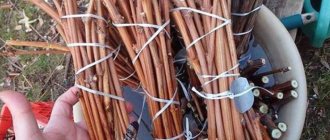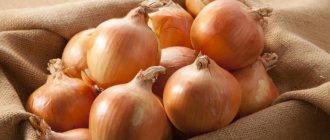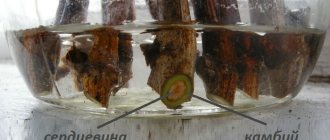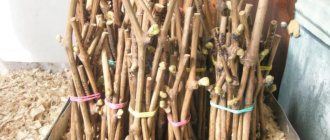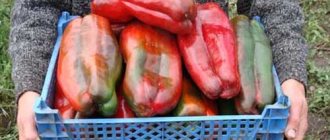Cutting time
If green chibouks are prepared in the spring, then the planting material that will be used next year begins to be cut out in the fall. At this time, the vines are being pruned, the grape bushes are being cleared of old and diseased stems, then it’s time to think about cuttings. Work is carried out before frost. At this time, the vine has already been saturated with healing substances, and future “children” will need them.
Experienced gardeners know that they need to start pruning and preparing cuttings when half a month has passed since the last leaf falls from the vine.
Not every vine is suitable for quality cuttings. You need to focus on those bushes that delight you with a large harvest. Brown vine is suitable for blanks, and it must be at least 8 millimeters thick. Internodes should be on it with an interval of 10 centimeters. And of course, cuttings are taken only from healthy bushes.
Preparation and care
A grape cutting suitable for further rooting is a piece of vine 55-65 centimeters long and 1-1.5 centimeters in diameter. Selection criteria: the presence of at least three living, well-developed buds and the maturity of the vine itself. It is checked by slightly bending the stem: a barely audible crack indicates that the vine is ready for cuttings. And you can also check the maturity of planting material with iodine. When interacting with it, the cut of the branch turns black.
Benefits of winter storage
Cuttings can be harvested and rooted in the spring, but this can harm the mother bush. After spring pruning, it will take a long time to recover and ultimately will not complete its task. And the chibuki themselves, planted in unheated soil after winter, take root very weakly. It’s a completely different matter with autumn cuttings, after which the mother bush is well reanimated during the winter months, and the stems, cut from mature and strong branches, get used to independent survival all winter at zero temperatures.
It is recommended to cut the chibuki in the last ten days of September, which exactly coincides with the pre-winter pruning of grapes. The deadlines for covered vineyards are shifted a month later. But in any case, this is done after dropping the leaves and the first frost. Harvesting grape cuttings for the winter at this particular time causes less harm to the bush itself, since it is preparing for winter - life support processes slow down.
For storage, annual three-bud cuttings cut from the middle part of the vine are selected. The suitability test is carried out on branches that are quite difficult to bend and have a light brown color. A green vine with wrinkled bark is not suitable for cuttings. This is immature material.
It is very important not to allow diseased shoots to be collected for planting material. They can be distinguished by dirty spots and an unpleasant odor. Having discovered such a vine, it must be immediately cut off and burned. And outside the vineyard area. Even ash can be dangerous to plants.
How to prepare cuttings for storage
In order for the planting material to be suitable in the spring, all conditions must be created so that the cuttings do not lose moisture. The fact is that due to a lack of moisture, the eyes die, the root system develops poorly, and such material will not be able to take root.
What gardeners need to do:
- The trimmed vine is placed in water overnight.
- The procedure for disinfecting the pipes is carried out. For this purpose biological products are used. You can take, for example, “Phytodoctor”. A solution of copper sulfate is also suitable. For processing, use a sprayer.
- After spraying, the chibouks are dried.
- A good option is to use a paraffin coating. Some gardeners use plasticine. Such materials seal moisture inside the vine, so it will be protected from moisture deficiency.
Storing grape cuttings in winter, the simplest and most reliable methods
Setting up a luxurious vineyard on your own property is quick and easy. Even an inexperienced gardener can cope with this. There are several basic ways to plant grapes:
- seedlings;
- cuttings;
- layering.
Cuttings are a vegetative propagation method, as a result of which a young plant appears from part of an old shoot - a cutting. For the propagation process, cuttings of a one-year-old fruit-bearing vine, called chubuks, are most often used. They may be green or woody.
The process is very labor-intensive and not the easiest. However, the success of the operation depends on proper compliance with all instructions.
How to properly prepare chibouks for storage?
To prepare material for planting, select a healthy grapevine with a diameter of up to 1 cm, and cut off its upper part. Leaves, tendrils, and unripe tops are removed from the cut shoots, keeping 4 eyes.
The upper cut is made a few centimeters above the upper bud. The lower part is cut vertically in three places, forming a cut about 3 cm in length. This procedure will ensure normal metabolism in the cuttings after planting in open ground.
The procedure is carried out with a sharp knife at an angle. It is important to prepare gardening tools before starting the operation. To do this, it is cleaned and processed to prevent the spread of diseases. Attention! Pruning the shanks is extremely important.
If you cut the cutting incorrectly, it will dry out or die. If you are preparing cuttings of different varieties, they must be labeled and collected in bunches. This is done to prevent plants from infecting each other while at rest. Then they are immersed in water for a day.
Then it is treated with a 5% solution of copper sulfate and dried well. After this, they are placed in plastic wrap and sent for storage. The cuttings should survive the winter, get stronger, and in early spring they can be planted in open ground in a permanent place of growth.
Important! Treating cuttings with water and vitriol not only promotes disinfection, but also accumulates a supply of nutrients that will help the plant survive hibernation.
When is it time to sprout
20 days before planting, the stems are removed from storage and the cuts are renewed - the lower one is made under the node perpendicular to the axis of the cutting, the upper one is 2 cm above the eye, obliquely in the direction opposite to the eye.
Furrowing the bottom of the shank will allow the roots to hatch faster. Longitudinal damage to the bark is caused by running one or two internodes along the teeth of a garden saw. If the stalk is full size, then the lower end with two eyes is furrowed; if it is two-eye, the lower third is furrowed.
How to choose good planting material?
The success of the operation directly depends on the quality of the planting material. Before you start pruning, select healthy and strong cuttings. You need to start with a preliminary inspection of the vine. The color of the shoots should be uniform brown-green. There should be no damage, cuts, stains or rot.
The diameter of a healthy stem should range from 0.6 to 1.0 cm. The length can vary from 12 to 60 cm. A shoot that is too short will not be able to survive the winter due to lack of strength and nutrients. Cuttings that are too long do not store well.
Preserving 2 to 4 buds will allow the plant to quickly take root and immediately enter the development and growth phase when transplanted into open ground.
Storage technologies before planting in the ground
During storage, the plant loses half of its nutrients and quickly weakens, becoming unsuitable for planting. The main objective of the procedure is to reduce losses. You can store cuttings in the basement, refrigerator or buried in the ground. Low temperature and darkness slow down vital processes and lead to a decrease in nutrient consumption.
How to store in a basement or cellar?
When storing pipes in the basement, it is important to ensure that the temperature is constant. It should not fall below 0 degrees. Otherwise, the air will become too cold and the vine will freeze. It is important not to allow the temperature to rise above +4 degrees. In this case, the buds will begin to swell and bloom ahead of time.
You can regulate the temperature and humidity conditions of the room by providing ventilation and airing.
It is important to ventilate the cuttings themselves. To do this, several holes are made in the plastic film with which the shoots are wrapped. At least once a month, the film is unrolled and the cuttings are inspected. If mold forms, wipe it with a cloth soaked in a solution of copper sulfate. When the vine dries out, it is moistened with water.
Another popular way to retain moisture and reduce nutrient loss is to use wet sand or pine sawdust. To do this, they are added in small quantities to a plastic bag in which the cuttings are stored.
Storage rules: comfortable conditions for storing cuttings
Favorable conditions should be created for the Chubouks.
If you plan to store planting material indoors, the following parameters must be observed:
- Temperature – from 1 to 4 degrees Celsius.
- Humidity – from 90 to 100 percent.
- Hiding from sunlight so that the chibouks sleep peacefully until spring.
- Room ventilation. Stagnant air will cause the development of diseases, infections, and mold.
- The premises must be protected from pests.
If these rules are not followed, then the grape harvests, selected with such love and care, will weaken, lose the ability to take root, and the buds will die.
Storage
Covering the grapes and preserving the stems can be done in various ways.
Underground
The site should not be prone to stagnation of water and protected from sunlight. You need to place the pipes vertically in the hole and cover them with a layer of about 50 cm of earth. Drainage grooves need to be made near the trench.
In the basement, cellar
Chubuki must be sprinkled with damp, clean sand. The storage temperature of grape cuttings in the cellar must be maintained at about +5 degrees Celsius.
In the snow in a box
If there are a small number of chopped vines, then it is convenient to store them in boxes. The bottom needs to be sprinkled with a layer of sand up to 15 cm, then the pipes should be laid, and the sand should be refilled. The box is covered with snow and left until spring.
In a refrigerator
In the refrigerator, storing grape cuttings in plastic bottles in winter is as follows. It is necessary to cut two bottles and make holes in them for ventilation, then fill them with wet sand and place them on the bottom shelf.
Waxing
Paraffinization is a technological method of applying a small film of a protective layer to the top of the stems by immersing the vine in molten paraffin.
Where to store grape cuttings until spring at home
Chubuki can be stored in various ways, the main thing is that the general rules are followed. For storage use boxes, film, fabric, sand, moss.
Cold storage
To place the cuttings in the refrigerator, they are first wrapped in a cloth soaked in a vitriol solution, always 3 percent. This roll is placed in polyethylene and left on a shelf in the refrigerator. The contents of the package are checked approximately once every 30 days. In this case, you need to spray the cuttings and wipe them with a solution of vitriol. If mold forms, it is removed.
Cellar storage
If the house has a cellar, planting material is stored there. To do this, put the pipes in polyethylene and leave them, for example, on a rack. However, from time to time you need to see how the cuttings feel, wipe with a disinfectant solution to prevent mold from forming, and sprinkle with water to prevent thirst.
In the cellar you can also install a box moistened with sand, where you can place the bunches. Some gardeners prefer to use sawdust instead of sand.
Storing cuttings buried in trenches
Experienced gardeners believe that trench storage is one of the best storage options. However, you must follow the rules:
- A trench is dug in an area where water does not flow or remain.
- To prevent snow from accumulating, it is worth building a support for it. Or use a place near the fence.
- Sand, previously moistened, is poured into the bottom of the trench.
- The bundles are tied. Indicate the marking.
- Place planting material on sand.
- Covered with sand.
- A new batch of cuttings is laid.
- Cover it with sand again.
- Cover the trench with soil.
- Boards are placed on top to protect from external factors.
Storing cuttings in the snow
If climatic conditions allow, you can use this method. The main thing is that there is a lot of snow on the site.
The prepared bunches are wrapped in plastic wrap and placed under the snow. This protective layer should be 30 centimeters. The place where the pipes are hidden is compacted. Planting material is obtained only in the spring.
Sorting grape cuttings by variety
It would be useful to remind you that all chibouks must be sorted by grade, tied into bundles and signed. You can tie them together with wire, rope, or, like I did, masking tape. I also wrote the names of the varieties on tape - very convenient.
- Loosestrife: growing in the garden, propagation, types and varieties
However, even such a responsible approach will not protect you from mis-grading: you could have been mistakenly sent the wrong variety that you ordered, since even the best specialists sometimes make mistakes.
How to save purchased seedlings before planting
The seedling purchased for planting must be of good quality:
- Have a developed root system;
- Have elastic growth;
- With healthy leaves;
- The cuts should be green and juicy.
Seedlings need to create comfortable conditions for them so as not to spoil the planting material.
Purchased seedlings must be placed in a container filled with wet sand. But a very wet composition is not needed, 10 percent humidity is enough. But before that, the roots need to be processed. Usually a solution of manganese is prepared, which gives the plant protection against diseases.
If the seedlings have been without water for a long time, their roots have dried out, then a bath will be required. That is, the plants are soaked in water and kept for 24 hours, no less. Experienced gardeners use melt water for these purposes.
When burying roots, you need to make sure that the neck of the root remains outside.
The seedlings are stored in a room where the temperature is not higher than 5 degrees, but not lower than zero. The room must be humid.
The sand should be periodically moistened to prevent it from drying out. One way to maintain soil moisture is to use snow. Gardeners put snow on the sand, it gradually melts, and the sand becomes wet.
You can also store seedlings on the site. To do this, prepare a deep hole where the seedlings are placed. Compost or peat goes on top, sawdust is also suitable. In this shelter the seedlings will wait until planting time.
Three ways to preserve grape seedlings
Instructions on how to keep plants in the basement, refrigerator or garden until planting season.
In a hole or basement
You can store plants vertically or horizontally:
- When choosing a vertical method, only the lower part of the additive is covered with soil. The gap between the seedlings and the wall is covered with earth. With this method, it is necessary to ensure that light does not fall on the additives.
- When storing planting material horizontally, place the plants on an earthen cushion , 7–10 cm thick, with roots facing each other. It is possible to store in stacks, alternating layers of soil and grapes. The top layer is made 15 centimeters thick.
With this method it is possible to control air and soil humidity and room temperature. This increases the chances of successful preservation of seedlings.
Keeping in the refrigerator
A method that requires large amounts of electricity. But you don’t need to monitor the thermometer readings. The average temperature in the refrigerator is maintained at +3 – 5°C .
The root system of the plant is stored in a mixture of sand and soil, in a canvas bag, because the thin roots can quickly dry out without a substrate. The plant can be placed on its side or placed in the refrigerator.
In the ground, in the garden
If there is no basement or hole, and the refrigerator is busy, then the seedlings can be stored in the country house . To do this, dig a rectangular hole in the ground . The depth of the trench depends on the depth of soil freezing in winter.
Grapes are placed in the hole, roots facing each other. Each layer is laid with earth. Make a layer of soil on top of at least 20 cm . The place is covered with moss or spruce branches . This measure will protect the seedlings from freezing if snow does not fall in winter.
In this method it is impossible to control temperature and humidity.
Spring preparation of cuttings for planting
Chubuki, which have overwintered and are ready for germination, are taken out of the shelter in late February and early March.
You must first update the cuts, and divide the long pieces into two or three parts. Chubuki are placed in a container with water and left for several days. In this case, the overall temperature should not be lower than 15 degrees. A good solution would be to use stimulants that will awaken the root system. The next stage is planting. Next comes kilching so that the roots become stronger and the buds do not yet think of blooming. By the way, in order for the roots to form better, scratches are applied to the sides of the chibouks.
Instead of kilching, you can use stratification. This is more suitable for gardeners who prepare planting material at home.
There are several steps to follow:
- Choose a container whose walls are as high as a bunch of grapes.
- Pour processed sawdust or previously steamed soil into the box. The layer is no higher than 2 centimeters.
- Grape bunches are placed vertically.
- Cover with soil or sawdust so that one peephole peeks out.
- It is necessary to set the desired temperature in the room - from 20 to 25 degrees Celsius.
- They must remain in such conditions for at least two weeks. It may take three weeks.
Another option is stratification in a package. In this case, the bundles are placed in polyethylene and hidden in a room where the temperature is set at 20-25 degrees. Once every three days, the bags are opened for ventilation. And the bundles need to be kept in bags for about two and a half weeks.
Gradually, root buds will begin to appear on the cuttings, and the upper eyes will produce green shoots.
To ensure that the roots grow intensively, gardeners use growth stimulants. It can be heteroauxin, hyperauxin.
Rooting methods
Rooting chubuks in winter accelerates the development of the vine by approximately 4 months.
In water
At the bottom of the jar, you need to lay a 3-4 cm layer of cotton wool and add a little weak solution of potassium permanganate. Afterwards the pipes are installed in the liquid. The bottom part of the jar needs to be insulated, and the top part needs to be created in cooler conditions.
In the ground
You need to pour a drainage layer into the bottle, add humus, sand and garden soil in equal parts on top. Chubuki need to be placed in a container and watered well. You can add perlite instead of sand, this will maintain stable soil moisture.
In the sawdust
Pre-soaked cuttings can be placed in damp sawdust. Before this, it is necessary to paraffin the top of the chibouk and wrap it in a damp cloth. Roots will appear in about a month.
How to protect chibuki during storage in spring
The main rule is to create the right atmosphere, that is, the temperature and humidity conditions must be observed. Due to non-compliance with the requirements, chubuks may “lag behind in development.” For example, the buds became active, but the root system did not form properly. In this case, it is necessary to use growth stimulants.
Another problem is that the root system is developing well, but the buds do not want to wake up. This is a consequence of incorrect temperature conditions in the room and insufficient air humidity. To improve the health of the plant, you need to sprinkle its upper eye with soil. In this case, the soil needs to be moist and comfortable for the chibouk. After some time, the kidneys will wake up.
In addition to creating favorable temperature and humidity in the room, it is important not to forget that the sun can be not only a friend, but also an enemy. Therefore, cuttings should not be kept in direct sunlight.
To prevent the cuttings from getting sick, they are disinfected. It is needed if signs of mold appear. A composition is prepared from copper sulfate diluted in water, and the bunches are coated with a brush. Instead of a brush, you can use a soft cloth.
Spring chibouks, which are already waking up, need to be preserved until planting. They can’t go into open ground yet, the weather outside is not right. What to do?
Cuttings that have entered the vegetative stage should be placed in cardboard packaging. The walls of such a structure must be at least 30 centimeters. The diameter of the temporary “house” is approximately 10 centimeters. These cardboard “houses” are placed in a box. The main thing is that there are holes in the bottom and walls of the container. Place paper on the bottom. Soil 5 centimeters high is placed in cardboard containers. Press down slightly and place the germinated cuttings on it.
Fill the container with soil and water it. The soil mixture can be from forest and turf soil, a mixture of peat with humus, and sand. The “houses” are located in a bright room, under a film. You need to ensure that the soil does not dry out and that the room temperature is comfortable. So the seedlings will wait until May, when they will move to their permanent “place of residence” - to the garden plot.
Size of grape cuttings for storage
The ideal sample is a shank as thick as the diameter of a pencil, that is, 7.5 mm, but in reality it can be either a little thinner or a little thicker, but 12 mm is the upper limit. A cutting that is too thin can also take root safely, but it will take a lot of time to grow it into a normal seedling.
The length of the stems is cut with a margin of 50-70 cm. The longer the cutting, the more nutrients and moisture it contains, and the excess length can be trimmed in the spring.
Reviews from experienced gardeners: mistakes when storing cuttings
– To prevent the cuttings from losing their nutritious juices during storage, I lubricate the cuts with paraffin. I store them in the refrigerator. When I first started working in the vineyard, I didn’t think about protecting the cuts, and as a result, my stems began to dry out. I had to soak it.
Victoria, Krasnodar
– On the one hand, it is recommended to store it in polyethylene, but on the other hand, this is a real breeding ground for infection! But I solved the problem simply: I treat the cuttings with preparations containing copper, and the polyethylene needs to be pierced in several places so that the cuttings do not suffocate. Somehow I forgot about this procedure, packed it in thick film and spread the mushrooms on the grapes.
Elena, Gai-Kodzor
– Last year I lost all the planting material. I kept the stems in a shed on the garden plot, the weather seemed to be quite good, but when it fell below zero, all the shoots froze. Now I store it in the refrigerator.
Evgeniy, Samara
“We’re okay with snow, so I store the pipes in a trench.” I’ll cover it well, cover it with snow and trample it down. True, I won’t disturb the burial site until spring. When the snow melts, then I take out the chibouks.
Alexandra, Tyumen
“My father worked in the vineyard for many years. He kept bunches of grapes in a trench. How did you check what temperature was in the ground? I left the thermometer in it for a while. This was the most accurate test.
Ilya, Kostroma
– If the storage pit is not lined with slate, the walls will crumble over time and it will be inconvenient to remove planting material. I always do this now. And I just cover it with slate on top.
Alexander, Novorossiysk
– For many years they could not understand the reason - all the bunches of grapes left for storage became covered with mold. And they did this: they wrapped the tied cuttings in damp paper and put them in the cellar. The temperature in the cellar was just over 5 degrees Celsius, is that a big deal? But it turned out that it was the wrong temperature that caused mold to form. If there are even microscopic spores on the chibouk, then mold will certainly appear. Then I found out that the reason also lay in the damp paper.
Victoria, Kurgan
“I usually store the bunches in slightly damp sand, but here I overdid it - I wet the sand too much.” Grapes, of course, love moisture, but not that much. I had to save the situation before mold grew - I covered it with dry sand.
Maxim, Veliky Ustyug
Natalia
Author
Ask a Question
If you choose the right vine for taking cuttings, if you store it in the right conditions, then by spring you can provide yourself with good quality planting material. This means that the seedlings will be strong, and the grape bushes will delight you with a large harvest.
How to trim cuttings
Pruning begins after the leaves fall. In regions where frosts come early, grapevines should be pruned earlier. It is best to leave five internodes on each cutting.
Since some eyes may not survive winter storage, they will have to be trimmed. The length of the shank should be about 70 cm. This is convenient for renewing dried cuts in the spring.
Pruning is done with a well-sharpened pruning shears, having previously treated it with a disinfectant, so as not to introduce any infection. The lower part is cut right below the node, and the upper part in the middle of the internode. The cuts are made obliquely.
Under what conditions should it be stored?
Storage of grape cuttings in winter should take place at a temperature of +2°C - +6°C. The optimal humidity level is considered to be 60%. In a drier place, planting material will actively lose moisture.
It is important that the room where grape stems are stored is equipped with good ventilation.
In basements, planting material must be protected from rodents, otherwise they will quickly destroy it.
The condition of the cuttings should be checked at least once a month. If it becomes noticeable that they are too dry, they are kept in water for 6 hours. After soaking, the planting material is dried in the same way as when preparing for storage.
It will be more difficult to preserve grape cuttings in winter in a room that is too humid. They will quickly begin to become moldy, and if the necessary measures are not taken in time, they will die.
The fungus can be destroyed using the same solution of potassium permanganate or copper sulfate that is used for preventive disinfection. But before processing, the cuttings are washed well with clean water.
The best recommendations on how to store grape seedlings and cuttings before planting
In order to plant grapes at your summer cottage when spring comes, you need to start preparing young plants in the fall. It is important for everyone who decides to grow grapes on their own plot to know how to preserve grape seedlings before planting. There are many ways to store grapes, and every gardener will be able to choose the most convenient one for himself.
Germination of cuttings and planting
Planting cuttings in open ground is carried out in early spring. Before starting the procedure, the tufts must be prepared and rooted.
To do this, a couple of weeks before planting, they are taken out of storage and transplanted into plastic cups. This will help the plant quickly adapt and break dormancy.
First, the cuttings are soaked for up to 48 hours in warm water. Then several holes are made at the bottom of the cups. Then earth and humus. Sprinkle fine sand on top. The cutting is placed in the center to a depth of about 4 cm and then watered.
You can learn more about the process from the video.
Preparation of pipes
To prepare grape cuttings, you need to know some rules:
- The stem is cut from the lower or middle part of the fruit-bearing vine. This is a requirement.
- Before cutting, the vine must be checked for maturity. To do this, you need to bend it slightly. If the vine is mature, a characteristic cracking sound will be heard.
- Additionally, the vine is checked for maturity using regular iodine. After applying iodine to a cut of the vine, it should turn black.
- You should not choose a vine that is thick or too thin. The optimal thickness for cutting a shank is 0.7 cm.
- The length of the cuttings should be 60-70 cm. When spring comes, such cuttings are cut into several more, about 25 cm each. Each of them should have 2-3 buds.
- The pipes are harvested at the end of the growing season. It is not recommended to do such an event in spring due to the low percentage of plant survival.
How to choose good planting material?
The success of the operation directly depends on the quality of the planting material. Before you start pruning, select healthy and strong cuttings.
You need to start with a preliminary inspection of the vine. The color of the shoots should be uniform brown-green. There should be no damage, cuts, stains or rot.
The diameter of a healthy stem should range from 0.6 to 1.0 cm. The length can vary from 12 to 60 cm. A shoot that is too short will not be able to survive the winter due to lack of strength and nutrients. Cuttings that are too long do not store well.
Preserving 2 to 4 buds will allow the plant to quickly take root and immediately enter the development and growth phase when transplanted into open ground.
